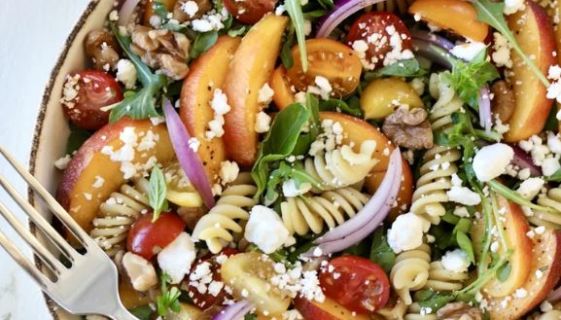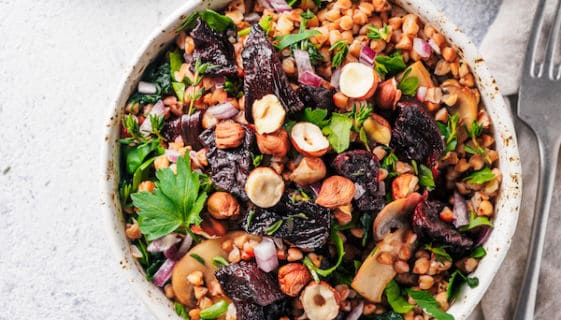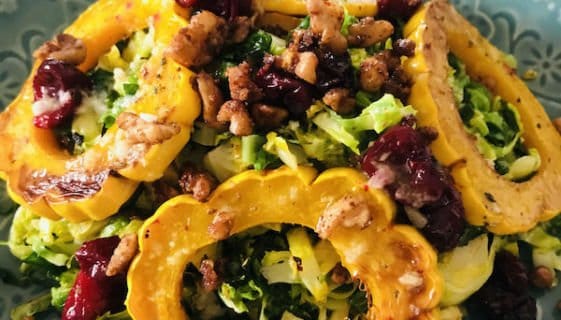In this recipe, traditional pesto gets a twist by adding spinach, arugula, peas, and mint to produce a nutrient-rich delectable sauce that is also dairy and nut free. This tasty dish packs in many delightful flavors spring has to offer by combining in-season produce with tender pasta that is then coated in a bright, zesty, lemony-flavored pesto.
It is perfect for potlucks and BBQs and can be a deliciously nutritious weekday meal. The wholesome ingredients provide an array of anticancer, antioxidant, and gut-supporting properties to help energize our bodies to welcome the change of season. Best of all, this dish comes together in under 30 minutes!
Pesto Pasta Summer Salad
Ingredients
Pesto
- 1 cup spinach
- 1 cup arugula
- ½ cup mint
- 2 cups basil
- 1 cup peas
- 1 lemon, juiced and zested
- ¼ cup olive oil
- 2-4 cloves garlic
- ¼ tsp salt
- 1-2 tbsp water
Pasta
- 1 box of pasta (I use Jovial GF Pasta)
- 1 tbsp oil
- 1 bell pepper, diced (any color works, red is my favorite)
- 2 cups mushrooms, sliced
- 1 bunch of broccoli, chopped
- ½ red onion, sliced
Directions
- Make the pesto sauce by combining all pesto ingredients except the olive oil and water in a food processor or high-powered blender and blend until well combined. Add in the olive oil and 1 tbsp of water. Blend until smooth. Taste and adjust the seasoning; you may have to add more water to reach desired consistency. Once the pesto is made, set it aside.
- Boil water, add to water 1 tablespoon of oil to keep the pasta from sticking, and sprinkle in some salt to flavor the pasta. Cook pasta according to the directions on the box. Drain when cooked to your preference, and then run under cold water to stop the cooking process.
- Place pasta in a large bowl and combine with ½ the pesto and gently mix to combine.
- While pasta is cooking, heat up a large sauté pan over medium heat and add oil. Add mushrooms, bell peppers, broccoli, and onions, and season with salt and pepper. Cook for 10 minutes, tossing occasionally, and allow vegetables to brown.
- When veggies are done cooking, add to the pasta and gently toss to combine. Taste and add more pesto if you like to reach your desired taste.
- Garnish with fresh herbs, lemon zest, and red pepper flakes.
Nutrition
Basil: Contains a range of protective vitamins such as Vitamins A, C, and K, as well as essential oils with high antioxidant properties due to the phytochemicals that help reduce oxidative stress in the body. These phytochemicals are known to reduce the risk of cancer but also prevent age-related macular degeneration, and support liver and cardiovascular health. A unique component of basil is its ability to enhance and preserve the healthful properties of other ingredients it is combined with.
Garlic: Considered a prebiotic, meaning it feeds the “good” bacteria in our gut and promotes a healthy digestive system. Research supports that the compounds in garlic, such as allicin, have antioxidant, anti-inflammatory, antimicrobial, and cardioprotective properties. If you chop your garlic 10-15 minutes before using, it will have the maximum amount of active allicin.
Citrus juice and zest: Packed full of a multitude of nutrients such as vitamin C, flavonoids, and fiber which aid in vascular protection, reduce inflammation, improve gastrointestinal function and health, and play an important role in preventing diabetes, cancer, and neurological disease. The vitamin C in the lemon juice will aid in the intestinal absorption of the iron in the spinach and peas.
Spinach: Greens such as kale, spinach, collards, mustard greens, arugula, and chard have been shown to protect bones from osteoporosis, reduce inflammation, support a healthy gut, strengthen the immune system, protect cognition, and supply a high amount of antioxidants. They are considered to be among some of the best cancer-preventing foods.
Green Peas: A great source of plant-based protein content and high amounts of fiber to support a healthy digestive tract and iron to aid in adequate cellular oxygenation. The high fiber and protein content can play a role in maintaining desirable blood sugar levels.
Olive Oil: A rich source of monounsaturated fats, olive oil contains antioxidants and omega-3 fatty acids that exhibit anti-inflammatory effects. Olive oil also promotes gut health.
Bell Peppers: All colors of bell peppers are from the same plant. A bell pepper starts out green and, as it ripens, will become yellow, orange or red, depending on the variety. As the bell pepper ripens, there is also an increase in the nutrient concentration, with orange and red having the highest. Bell peppers have high amounts of antioxidants called carotenoids that help protect cells from oxidative damage.
Mint: It is one of the rare herbs that are versatile enough to be used with equal success in sweet and savory dishes. The menthol in mint is a natural decongestant, and it also helps in relieving a sore throat. It aids digestion and gives relief to bloating and flatulence. It helps in alleviating allergy symptoms and helps to relieve nausea and headache.
Broccoli: A member of the Cruciferous family of vegetables, broccoli produces a compound called sulforaphane that has been shown to reduce tumor growth and cause cancer cells to self-destruct. It also boosts detoxifying enzymes and acts as an antioxidant, reducing oxidative stress and stabilizing blood sugar levels. Sulforaphane also aids in digestion by keeping the stomach lining healthy and the bacteria balance. It has also been shown to reduce inflammation and block the enzyme that causes joint destruction.



 Ananda Kaplan
Ananda Kaplan


